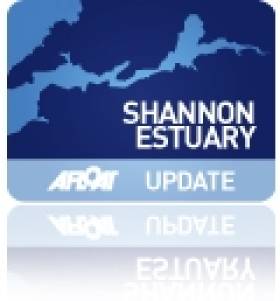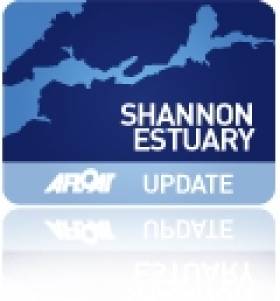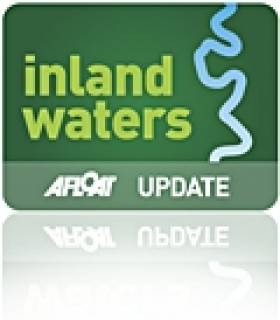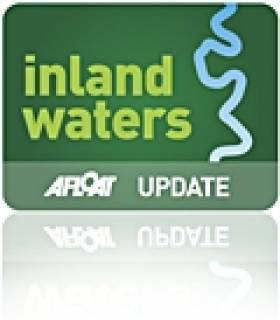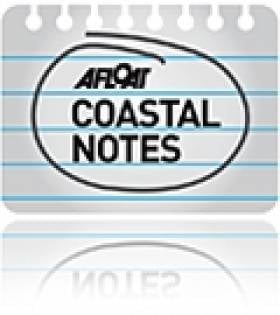Displaying items by tag: Shannon
Foynes Prepares to Celebrate Commodores Day
Commodore Tom Murray has a host of events planned for the day, racing will take place in the harbour area starting at 2pm. This is for all classes, Class 1, 2, White Sails and Mermaids. The junior members of the club will be sailing the Topaz dinghies.
It is hoped to have a live commentary of the racing from the clubhouse, to let the onlookers know what is happening on the water.
After racing the annual blessing of the boats will be performed by Canon O'Keeffe and Fr. Noonan, this will take place on the marina approximately at 4pm.
When the blessing of the boats is over, member's are asked to retire to the clubhouse for a Bar-b-Que and a traditional Irish music session, which will commence at 5pm.
The Foynes Irish Coffee Festival is back this year. The club is hosting a 'Fun Day', on Sunday, June 5 at 2pm. More details on this will follow next week.
The Waterways Ireland Inter-Counties Sailing Championships will be taking place on the Grand Canal Dock on Sunday, June 26.
A fleet of one-design keel boats will be provided, and a series of sprint sailing races of 15-20 minutes leading to the final.
A team from the club, which is spear-headed by Donal McCormack, includes Elaine O'Mahoney and John-Paul Buckley, Donal has a vacant place on the team, so any member who would like to participate are asked to contact the secretary, Elaine on 086 1231864. As far as Foynes Yacht Club are aware only one team representing the Shannon Estuary will be competing.
Foynes Flotilla Sails into Riverfest
A north-easterly force 3 wind accompanied the flotilla of yachts that set out from Foynes Yacht Club, who sailed to Limerick city on Saturday afternoon to participate in the Riverfest celebrations.
Daniel Butler co-ordinator took members of the Northside We're Ok youth group from Moyross, who experienced another view of Limerick from the river. John Prendergast and his wife, Maureen, were guests of the club on this cruise.
The yacht's that journeyed were Mweeloon, Whyte Dolphin, Alphara, Inizi, Mariposa, Lady Shanannah, Hello, Kilteery, Kerry Dream, Battle, Dexterity, Coral Dos and Blue Ribbon. Unfortunately, Marengo had to turn back at Aughinish because of engine trouble, the skipper, Pat Finucane and crew changed boats and were transported on on Ger Reidy's, Kilteery.
The sun shone all the way for the sight-seeing journey up this magnificent of stretch of water. The Islands on the Shannon Estuary Cannon and Horseshoe are one of the first sights that can be seen on this stretch of the river. The bauxite smelting factory, Aughinish Alumina and the famous Beeves Rock lighthouse, no more in use gives an added pictureesque setting to this journey.
Further on the right-hand side the entrance into the Deel Boat Club in Askeaton can be seen on the the same shore the pre-Norman Beagh Castle is standing overlooking the Shannon. Ringmoylan, and Pallaskenry can be seen down a mile from the castle, and opposite Rineanna with the famous Shannon Airport, who hosted several US President's who stopped off to visit this country.
As we continued our journey up river the landmark, Carrigagonnell Castle is visible, also the giant chimneys of the Cement factory in Mungret and the giant-sized structure of Thomond Park.
Nearer to the city Riverpoint and the Clarion Hotel, two of the tallest buildings in Limerick, rise up to the blue sky and sunshine of May.
When the flotilla approached the Clarion Hotel, they berthed for an hour to give the public a chance to see these water vessels in their bunting and memorabilia.
After the inspections were it was into Limerick Docks for an overnight stay, and then on to Dolan's Bar and Restaurant for a much sought-after meal.
On Sunday afternoon the junior members of the club, Ailish Chawke, Claire Lowes, Ciara McCormack, Mary McCormack and Anna Lowes gave a display of sailing kayaks and Topaz boats at Howley's Quay to an array of spectators, who came to see the other craft on the water, Jet-Ski's and Clark Clifford's rib who gave the public a trip up and down the Shannon. Members of the yacht club also gave out flyers promoting Foynes Yacht Club.
When the sailing adventures were over it was time to head back down river to Cooleen Point, where a Bar-b-Que followed in the Clubhouse the sailors and their families. Overall, the reaction from everybody was excellent!
Club racing continus every Wednesday evening with first gun at 7pm. On Saturday, May 14 and Sunday, May 15 the Estuary Bell will be raced in Foynes. Two races on Saturday and one of Sunday are pencilled in.
Tipperary Boat Dealer 'Closes the Doors'
Tipperary Boat dealer Marine Action Boats Ltd, based on the river Shannon at Birdhill has 'ceased operations' according to an announcement on the firm's website. The Sports boat dealership 'closed its doors' and ceased trading on December 31 2010, according to managing director, Tadhg Foley. Marine Action Boats were sole importers of Crownline Sports Cruisers for Ireland, according to the website. The sports boat section of the marine trade market has been one of the hardest hit by the economic downturn. The firm also handled brokerage, repairs and boat maintenance. The full text of the announcement is as follows:
"Despite great efforts from ourselves and our loyal team, we would like to announce that we have ceased operations at Marine Action Boats, and we are no longer trading. We would also like to thank all our customers and our suppliers for their support over the past decade".
Shannon-Erne Waterway to Reopen on April 1
Two Irish Boats for Transatlantic Race 2011
Two big names in Irish offshore racing are among the 30-boat fleet preparing for the Transatlantic Race 2011 (TR 2011) this June. Last night the organisers, the Royal Yacht Squadron, New York Yacht Club, Royal Ocean Racing Club and Storm Trysail Club, extended the deadline to enter the Race to March 31, 2011.
Adrian Lee's Cookson 50 from Dublin Bay and the Limerick Volvo 70 skippered by Ger O' Rourke's both make the entry list although the Shannon estuary's Chieftain is described only as a 'provisional' entry. For Entry list click HERE.
With the Transatlantic fleet now over 30 entries and many new inquiries following the success of the RORC Caribbean 600 - part of the companion Atlantic Ocean Racing Series - the organisers encourage those interested to enter the TR 2011 as soon as possible to secure a spot since the Notice of Race notes a maximum of 50 yachts for the race.
The TR 2011 will cover 2,975 miles from Newport, R.I., to the Lizard in England. The focus of pre-race activities will be the New York Yacht Club's Harbour Court clubhouse in Newport, R.I. There will be three staggered starts from June 26 to July 3. The awards ceremony on August 9th and other post-race activities will be held at the Castle, the home of the Royal Yacht Squadron in Cowes, England.
The fleet will include IRC Racing, IRC Racer/Cruiser, Classic and Open divisions with a minimum length overall (LOA) of 40 feet and no maximum. Competition is building within several segments of the diverse fleet, notably the 100' and up range which includes Sojana, Rambler 100, ICAP Leopard, and Maltese Falcon.
Tight racing is also expected in other classes and divisions, such as yachts in the under 50' range in IRC Racing and IRC Racer/Cruiser including the Class 40s - Concise 2, Dragon, and Kamoa'e, the Rogers 46s - Shakti and Varuna, as well as British Soldier ASA, Jacqueline IV, Sasha, Dawn Star, and Carina. For a complete list of entries click here.
All race documents are available HERE.
The TR 2011 is the centerpiece of the Atlantic Ocean Racing Series (AORS), and is organized in concert with the following clubs: Royal Malta Yacht Club, Annapolis Yacht Club, Ida Lewis Yacht Club, Montego Bay Yacht Club, Naval Academy Sailing Squadron, Jamaica Yachting Association, Antigua Yacht Club and Real Club Nautico de Sanxenxo.
Two races in the AORS have been completed: the Pineapple Cup - Montego Bay Race and the RORC Caribbean 600. The Pineapple Cup, from Ft. Lauderdale, Fla. to Montego Bay, Jamaica, a distance of 811 miles, was won by Genuine Risk, a 97-foot canting keel super maxi skippered by Hugo Stenbeck. In the RORC Caribbean 600, George David's Rambler 100, took line and overall IRC honors and set the monohull record of one day, 16 hours, 20 minutes and 2 seconds for the course's 600 miles.
Navigation Markers Out of Position on Lough Derg
The black Starboardhand marker "E" at Goat's Road and the Red Porthand marker in the middle of Coose Bay on Lough Derg on the inland waterways have been reported out of position. Waterways Ireland has asked Masters to navigate with due caution until these aids have been re-positioned.
Heritage Council's Online Marine Publications
The following topics below are just some of the categories featured, they include the Bere Island Conservation Plan, Ireland's Sharks & Rays, Conserving Ireland's Maritime Heritage and an Audit of Maritime Collections.
The maritime heritage section of the Heritage Council covers the cultural, physical and ecological dimensions. In addition it embraces the legacies of past generations, their traditions and natural features of both coastal and offshore environments.
For those interested in freshwater topics, the Heritage Council also recognises the importance of our inland waterways and canal network. The Heritage Council has undertaken a Waterway Corridor Studies on the Shannon, as well as on parts of the Grand and Royal Canals. For further information and downloadable in PDF format logn to www.heritagecouncil.ie/inland_waterways/
Warning - Snow Bound Harbours Pose Major Risk
Snow bound harbours and ice covered jetties in particular are dangerous to walk on or near because of the risk of slipping, tripping or falling near to the water's edge.
Sections of the Royal and Grand Canals and the Shannon Erne Waterway have restricted navigation due to ice accumulation.
Where water in lock chambers has frozen the public is warned not to attempt to cross over a lock in this state due to the great danger of ice cracking underfoot and being drowned in the lock.
Second Attempt to Airlift Injured Crewman Successful
The Shannon-based Coast Guard Helicopter reached the boat shortly before 2pm and succeeded in taking the fisherman, an Egyptian national, on board.
The man, who had sustained serious injuries after being struck by a steel hawser, was to be taken to Cork University Hospital.
An earlier attempt to airlift him from the vessel when it was 110km south of Kinsale had to be abandoned when the helicopter flew into a snowstorm and its cockpit window iced over.


























